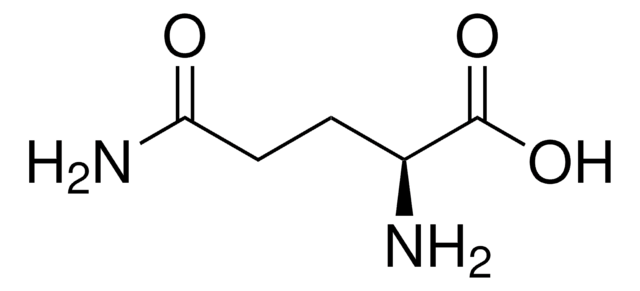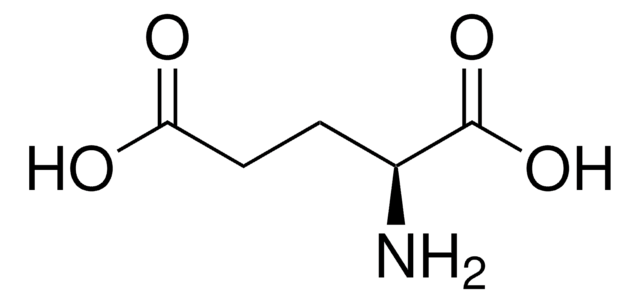G3126
L-Glutamine
≥99% (HPLC), ReagentPlus®
Synonym(s):
(S)-2,5-Diamino-5-oxopentanoic acid, L-Glutamic acid 5-amide, Levoglutamide
About This Item
Recommended Products
product name
L-Glutamine, ReagentPlus®, ≥99% (HPLC)
Quality Level
product line
ReagentPlus®
assay
≥99% (HPLC)
form
powder
impurities
≤0.2% free ammonia.
~0.5% Glutamic acid
color
white to off-white
mp
185 °C (dec.) (lit.)
solubility
1 M HCl: 50 mg/mL, clear to slightly hazy, colorless
cation traces
<0.2% (Ammonia (NH3))
application(s)
cell analysis
peptide synthesis
functional group
amide
storage temp.
room temp
SMILES string
N[C@@H](CCC(N)=O)C(O)=O
InChI
1S/C5H10N2O3/c6-3(5(9)10)1-2-4(7)8/h3H,1-2,6H2,(H2,7,8)(H,9,10)/t3-/m0/s1
InChI key
ZDXPYRJPNDTMRX-VKHMYHEASA-N
Gene Information
rat ... Ggt1(116568)
Looking for similar products? Visit Product Comparison Guide
Related Categories
General description
Moreover, L-Glutamine is essential for maintaining a delicate balance of ammonia in the body. This balance is crucial for preventing toxic ammonia levels. This amino acid facilitates the conversion of glutamic acid to glutamine, a process central to ammonia regulation. L-Glutamine is not only involved in nitrogen transport and energy production but also serves as a key player in various metabolic pathways. It participates in the biosynthesis of proteins, similar to other amino acids. Furthermore, it plays a significant role in the synthesis of urea and purines, vital components for nucleic acid production. L-Glutamine is also a vital resource for generating cellular energy, working closely with glucose for this purpose.
Another essential function of L-Glutamine is its contribution to nitrogen donation for multiple anabolic processes. These processes are vital for building crucial molecules, including purines, which are crucial for DNA production. This amino acid also provides carbon, replenishing the citric acid cycle, a central process in energy production within cells. L-Glutamine is a critical amino acid, acting as a nitrogen carrier, energy source, and contributing to protein synthesis and ammonia regulation. Its versatile functions make it a molecule of significant interest in the fields of cell biology, biochemical research, and metabolomics investigations.
Application
Biochem/physiol Actions
Features and Benefits
- Can be used in Metabolomics and Biochemical research
- High-quality compound suitable for multiple research applications
Other Notes
Legal Information
Application
comparable product
wgk_germany
WGK 1
flash_point_f
Not applicable
flash_point_c
Not applicable
ppe
Eyeshields, Gloves, type N95 (US)
Certificates of Analysis (COA)
Search for Certificates of Analysis (COA) by entering the products Lot/Batch Number. Lot and Batch Numbers can be found on a product’s label following the words ‘Lot’ or ‘Batch’.
Already Own This Product?
Find documentation for the products that you have recently purchased in the Document Library.
Customers Also Viewed
Chromatograms
application for HPLCapplication for HPLCOur team of scientists has experience in all areas of research including Life Science, Material Science, Chemical Synthesis, Chromatography, Analytical and many others.
Contact Technical Service
